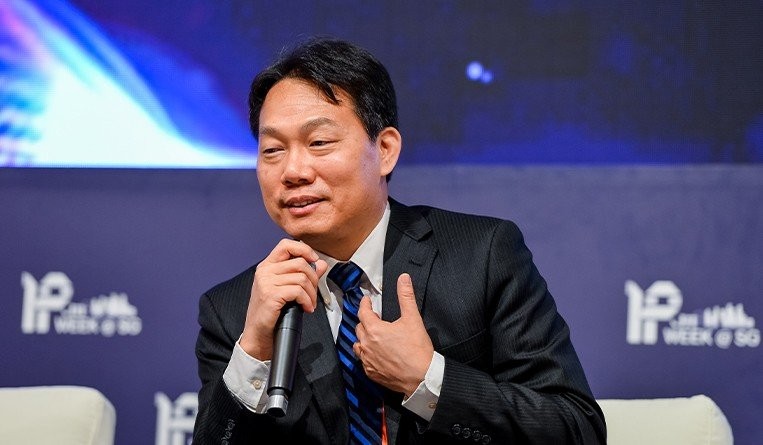Why AU Optronics puts a premium on patents
30 September 2019

The patents behind the flashy touch panels and other optical displays are important both in quantity and quality. Espie Angelica A. de Leon caught up with Spencer Yu, who handles IP for AU Optronics, at IP Week.
On the day this interview occurred – on August 28, at IP Week in Singapore – Touch Taiwan was ongoing at the Taipei Nangang Exhibition Center. Touch Taiwan is an annual exhibition of touch panel and optical film products.
Among those being showcased were the latest display technologies developed by Taiwan-based optoelectronic solutions manufacturer AU Optronics Corporation (AUO).
The company specializes in display panels for different applications, including LCD TVs, public message displays, desktop LCDs, notebooks, tablets, universal displays, videos, automotive, smartphone and wearable device applications. They come with high-resolution images in a full range of panel sizes.
The AUO innovations at Touch Taiwan in particular were the following: 17.3-inch OLED panels created through inkjet printing technology, 5.9-inch AMOLED panel with inside and outside folding capabilities, 12.1-inch full-color active Micro LED vehicle panel and the optical under-screen fingerprint identification technology. The latter is the first of its kind in the world.
While these products were being showcased to the world via Touch Taiwan, AUO’s intellectual property division director Spencer Yu was at the Marina Bay Sands Convention Centre in Singapore for IP Week @ SG 2019.
“I can say that whenever you see [our products], before that, we filed a patent first to protect our rights,” said Yu, who was the IP manager of the Industrial Technology Research Institute for 12 years prior to taking his current position.
According to its website, AUO has filed up to 25,800 patent applications as of July 2019. In fact, the company was the second biggest patent filer among Taiwanese firms during the first half of 2019, next to Taiwan Semiconductor Manufacturing Co. AUO’s total of 318 patent applications for the period marked a 30 percent increase from the previous year.
Overall, the company has more than 19,000 approved global patents under its belt.
“We keep our own pace on patent filing, without managing on the growth itself,” said Yu. “The increase may come from more innovations on new business, new applications of display, and even non-display.”
Though patent quantity is important, Yu said they give equal importance to patent quality.
“It is essential to the value of the patent. For example, in case there’s a need to bring a suit, only the patent with high quality can help, not the high number of patents,” he explained.
But first, they have to identify a valuable patent. “We have some angles to look at to see what is a good patent,” he said. “One is the invention itself. The invention should be very good. It resolves a very key and very good question.”
This means that the invention should offer a great solution to a problem which affects the industry or involves market needs. These are considered as “good problems” or “good questions” that should be answered or resolved by good solutions as well.
The next step is transforming this idea or solution into a good patent.
“A patent itself has its own quality issues. Sometimes you just convert an idea, but not ideally into a patent,” he said. “This is hard to imagine but it happens very often.”
The process is very critical to ensure patent quality and it’s also very technical. The company and the law firm should work together well to translate the idea into a very good patent, he said.
There is also the issue of patent mapping or patent landscaping which AUO is serious about.
“Once you have the map, you know which companies do what, collectively you know which direction they are into, what kind of questions they want to solve. So you can decide if you want to solve the same questions or solve another question,” Yu explained. “But for us, this is only the tool. It’s just a part of the whole process.”
Using the patent map as a tool means they regard it as a helpful material which generates important disclosures to allow the conversion of ideas into a good patent.
Formed in 2001, AUO has grown to become a frontrunner in the industry with operations spanning Taiwan, Singapore, China, Japan, South Korea, the United States and Europe. It is also the first pure TFT-LCD manufacturer to be listed on the New York Stock Exchange.
The company and its products have reaped several awards. One of these is the 2019 Innovative Product Award handed out by the Central Taiwan Science Park to AUO for its 32-inch mini LED gaming display.
How has the company’s patent portfolio helped in its success?
“I believe it’s on three aspects,” said Yu. “First, it’s always necessary to transform a great innovation into patent right to reflect, invest in and secure business growth and of course, good possible expansion. Second, a patent portfolio brings extra value to the company in addition to helping business when it comes to various uses of the portfolio, say sale, license, or others. Third, a strong patent portfolio helps to sustain the premium position, especially when there’s need to claim, or counter claim when the company gets sued in this extremely competitive display industry. Remember, offense is the best defense.”
Yu has advice for SMEs on getting IP protection for their innovations: “SMEs may care more about the efficiency of getting patents due to limited resources. [They need to have] a way that can effectively evaluate ideas for patenting, manage claiming during filing of patent and analyze the value of a patent issued matters. A patent map for appreciating RD projects can even be introduced. I would say the resources being invested in patent affairs [should] enjoy a higher priority than physical manufacturing.”






